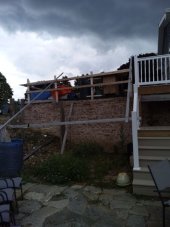agarg
New Member
Folks:
I have a grid tied solar operational with NEP BD800 micro inverters. On July 14, and 15th, I noticed that they were producing zero electricity in the middle of the afternoon when it was too hot. After a little diagnosis, I started to suspect if it was because of overheating. I have a charcoal roof with composite shingles and there is about 4 inch of space between the modules beneath the modules and the shingles.
To test this out, I took a hose and sprayed a lot of water to soak the modules and hoped that it would start producing again. AND it did.
Is this normal? Any suggestions?
Anil
I have a grid tied solar operational with NEP BD800 micro inverters. On July 14, and 15th, I noticed that they were producing zero electricity in the middle of the afternoon when it was too hot. After a little diagnosis, I started to suspect if it was because of overheating. I have a charcoal roof with composite shingles and there is about 4 inch of space between the modules beneath the modules and the shingles.
To test this out, I took a hose and sprayed a lot of water to soak the modules and hoped that it would start producing again. AND it did.
Is this normal? Any suggestions?
Anil



